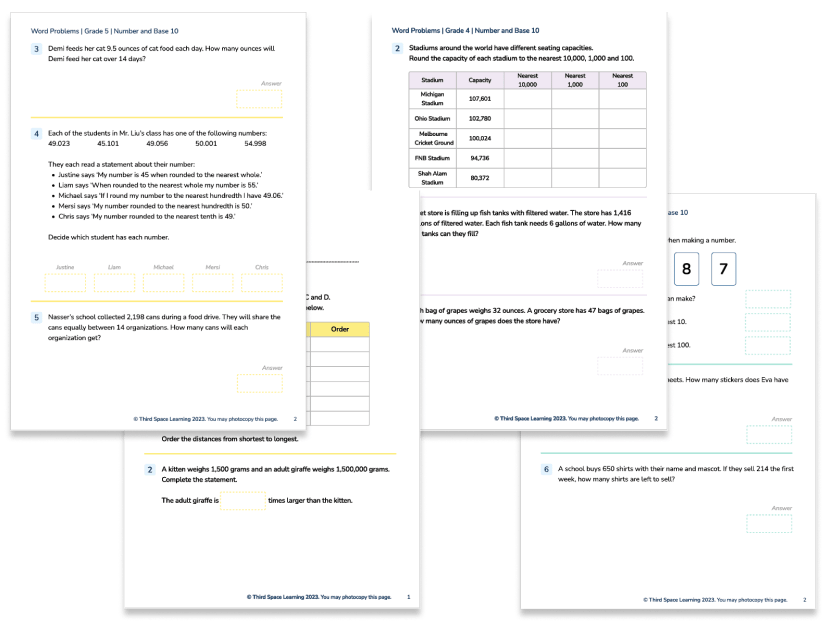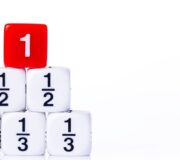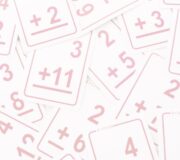Word Problems Explained For Elementary School Teachers & Parents
Solving word problems in elementary school is an essential part of the math curriculum. Here are over 30 math word problems to practice with children, plus expert guidance on how to solve them.
This blog is part of our series of blogs designed for teachers, schools, and parents supporting home learning.
What is a word problem?
A word problem in math is a math question written as one sentence or more that requires children to apply their math knowledge to a ‘real-life’ scenario.
This means that children must be familiar with the vocabulary associated with the mathematical symbols they are used to, in order to make sense of the word problem.
For example:
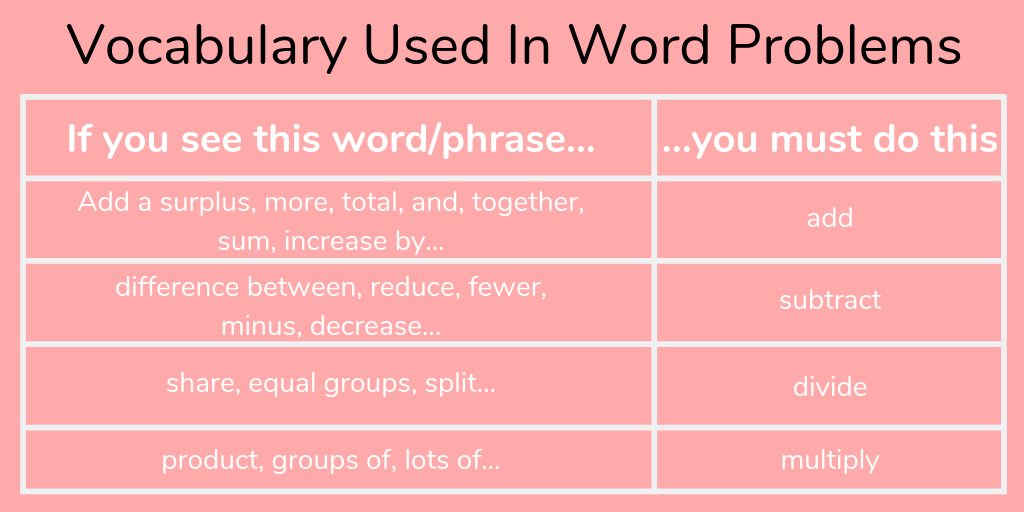
Word Problems Grade 4 Number and Base 10
11 grade 4 number and base 10 questions to develop your students' reasoning and problem solving skills.
Download Free Now!Isn’t brilliant arithmetic enough?
In short, no. Students need to build good reading comprehension, even in math. Overtime math problems become increasingly complex and require students to possess deep conceptual understanding and the ability to recall and apply knowledge rapidly and accurately.
As students progress through their mathematical education, they will need to be able to apply mathematical reasoning and develop mathematical arguments and proofs using math language. They will also need to be dynamic, applying their math knowledge to a variety of increasingly sophisticated problems.
To support this schools are adopting a ‘mastery’ approach to math
“Teaching for mastery”, is defined with these components:
- Math teaching for mastery rejects the idea that a large proportion of people ‘just can’t do math’.
- All students are encouraged by the belief that by working hard at math they can succeed.
- Procedural fluency and conceptual understanding are developed in tandem because each supports the development of the other.
- Significant time is spent developing deep knowledge of the key ideas that are needed to support future learning. The structure and connections within the mathematics are emphasized, so that students develop deep learning that can be sustained.
(The Essence of Maths Teaching for Mastery, 2016)
Mastery helps children to explore math in greater depth
Fluency in arithmetic is important; however, with this often lies the common misconception that once a child has learned the number skills appropriate to their grade level/age, they should be progressed to the next grade level/age of number skills.
The mastery approach, and the Standards for Mathematical Practice, encourages exploring the breadth and depth of these math concepts (once fluency is secure) through reasoning and problem solving.

Meet Skye, the voice-based AI tutor making math success possible for every student.
Built by teachers and math experts, Skye uses the same pedagogy, curriculum and lesson structure as our traditional tutoring.
But, with more flexibility and a low cost, schools can scale online math tutoring to support every student who needs it.
Find out moreHow to teach children to solve word problems?
Here are two simple math strategies for problem solving that can be applied to many word problems before solving them.
- What do you already know?
- How can this problem be drawn/represented pictorially?
Let’s see how this can be applied to word problems to help achieve the answer.
Solving a simple word problem
There are 28 students in a class.
The teacher has 8 liters of orange juice.
She pours 225 milliliters of orange juice for every student.
How much orange juice is left over?
1. What do you already know?
- There are 1,000ml in 1 liter
- Pours = liquid leaving the bottle = subtraction
- For every = multiply
- Left over = requires subtraction at some point
2. How can this problem be drawn/represented pictorially?
The bar model, also known as strip diagram, is always a great way of representing problems. However, if you are not familiar with this, there are always other ways of drawing it out.
Read more: What is a bar model
For example, for this question, you could draw 28 students (or stick man x 28) with ‘225 ml’ above each one and then a half-empty bottle with ‘8 liters’ marked at the top.
Now to put the math to work. This is a 5th grade multi-step problem, so we need to use what we already know and what we’ve drawn to break down the steps.
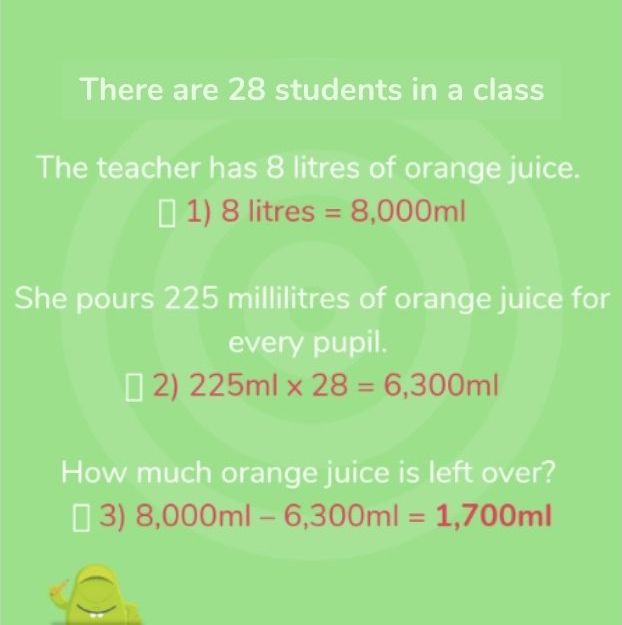
Solving a more complex, mixed word problem
Mara is in a bookshop.
She buys one book for $6.99 and another that costs $3.40 more than the first book.
She pays using a $20 bill.
What change does Mara get? (What is the remainder?)
1. What do you already know?
- More than = add
- Using decimals means I will have to line up the decimal points correctly in calculations
- Change from money = subtract
2. How can this problem be drawn/represented pictorially?
See this example of bar modelling for this question:
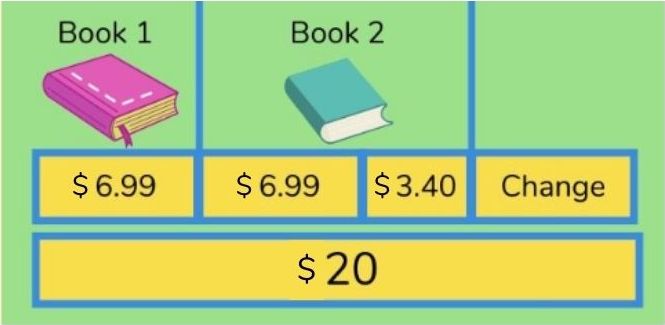
Now to put the math to work using what we already know and what we’ve drawn to break down the steps.
Mara is in a bookshop.
She buys one book for $6.99 and another that costs $3.40 more than the first book. 1) $6.99 + ($6.99 + $3.40) = $17.38
She pays using a $20 bill.
What change does Mara get? 2) $20 – $17.38 = $2.62
Math word problems for Kindergarten to Grade 5
The more children learn about math as they go through elementary school, the trickier the word problems they face will become.
Below you will find some information about the types of word problems your child will be coming up against on a year by year basis, and how word problems apply to each elementary grade.
Word problems in kindergarten
Throughout kindergarten a child is likely to be introduced to word problems with the help of concrete resources (manipulatives, such as pieces of physical apparatus like coins, cards, counters or number lines) to help them understand the problem.
An example of a word problem for kindergarten would be
Chris has 3 red bounce balls and 2 green bounce balls. How many bounce balls does Chris have in all?
Word problems in 1st grade
First grade is a continuation of kindergarten when it comes to word problems, with children still using concrete resources to help them understand and visualize the problems they are working on
An example of a word problem for first grade would be:
A class of 10 children each have 5 pencils in their pencil cases. How many pencils are there in total?
Word problems in 2nd grade
In second grade, children will move away from using concrete resources when solving word problems, and move towards using written methods. Teachers will begin to demonstrate the adding and subtracting within 100, adding up to 4- two-digit numbers at a time.
This is also the year in which 2-step word problems will be introduced. This is a problem which requires two individual calculations to be completed.
2nd grade word problem: geometry properties of shape
Shaun is making shapes out of plastic straws.
At the vertices where the straws meet, he uses blobs of modeling clay to fix them together
Here are some of the shapes he makes:
| Shape | Number of straws | Number of blobs of modeling clay |
| A | 4 | 4 |
| B | 3 | 3 |
| C | 6 | 6 |
One of Sean’s shapes is a triangle. Which is it? Explain your answer.
Answer: shape B as a triangle has 3 sides (straws) and 3 vertices, or angles (clay)
2nd grade word problem: statistics
2nd grade is collecting pebbles. This pictogram shows the different numbers of pebbles each group finds.
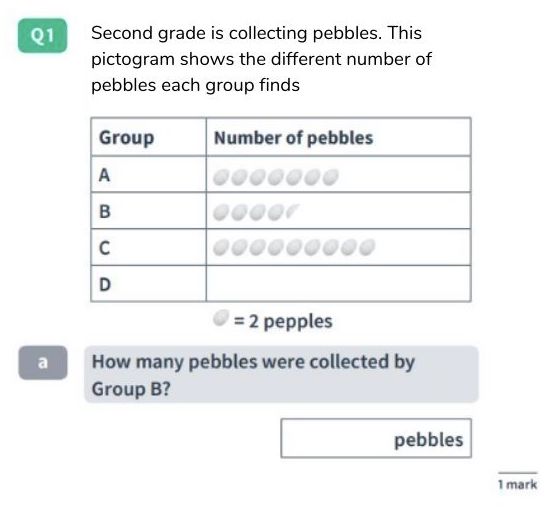
Word problems in 3rd grade
At this stage of their elementary school career, children should feel confident using the written method for addition and subtraction. They will begin multiplying and dividing within 100.
This year children will be presented with a variety of problems, including 2-step problems and be expected to work out the appropriate method required to solve each one.
3rd grade word problem: number and place value
My number has four digits and has a 7 in the hundreds place.
The digit which has the highest value in my number is 2.
The digit which has the lowest value in my number is 6.
My number has 3 fewer tens than hundreds.
What is my number?
Answer: 2,746
Word problems in 4th grade
One and two-step word problems continue in fourth grade, but this is also the year that children will be introduced to word problems containing decimals.
4th grade word problem: fractions and decimals
Stan, Frank and John are washing their cars outside their houses.
Stan has washed 0.5 of his car.
Frank has washed 1/5 of his car.
Norm has washed 2/5 of his car.
Who has washed the most?
Explain your answer.
Answer: Stan (he has washed 0.5 whereas Frank has only washed 0.2 and Norm 0.4)
Word problems in 5th grade
In fifth grade children move on from 2-step word problems to multi-step word problems. These will include fractions and decimals.
Here are some examples of the types of math word problems in fifth grade will have to solve.
5th grade word problem: ratio and proportion
The Angel of the North is a large statue in England. It is 20 meters tall and 54 meters wide.
Ally makes a scale model of the Angel of the North. Her model is 40 centimeters tall. How wide is her model?
Answer: 108cm
5th grade word problem: algebra
Amina is making designs with two different shapes.
She gives each shape a value.
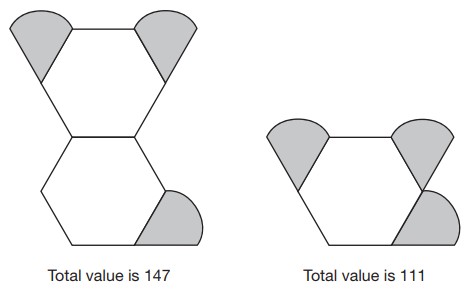
Calculate the value of each shape.
Answer: 36 (hexagon) and 25.
5th grade word problem: measurement
There are 28 students in a class.
The teacher has 8 liters of orange juice.
She pours 225 milliliters of orange juice for every student.
How much orange juice is left over?
Answer: 1.7 liters or 1,700ml
Topic based word problems
The following examples give you an idea of the kinds of math word problems your child will encounter in elementary school
4th grade word problem: place value
This machine subtracts one hundredth each time the button is pressed. The starting number is 8.43. What number will the machine show if the button is pressed six times? Answer: 8.37
Download free number and place value word problems for grades 2, 3, 4 and 5
2nd grade word problem: addition and subtraction
Sam has 64 sweets. He gets given 12 more. He then gives 22 away. How many sweets is he left with? Answer: 54
Download free addition and subtraction word problems for for grades 2, 3, 4 and 5
2nd grade word problem: addition
Sammy thinks of a number. He subtracts 70. His new number is 12. What was the number Sammy thought of? Answer: 82
5th grade word problem: subtraction
The temperature at 7pm was 4oC. By midnight, it had dropped by 9 degrees. What was the temperature at midnight? Answer: -5oC
3rd grade word problem: multiplication
Eggs are sold in boxes of 12. The egg boxes are delivered to stores in crates. Each crate holds 9 boxes. How many eggs are in a crate? Answer: 108
Download free multiplication word problems for grades 2, 3, 4 and 5.
5th grade word problem: division
A factory produces 3,572 paint brushes every day. They are packaged into boxes of 19. How many boxes does the factory produce every day? Answer: 188
Download free division word problems for grades 2, 3, 4 and 5.
Free resource: Use these four operations word problems to practice addition, subtraction, multiplication and division all together.
4th grade word problem: fractions
At the end of every day, a chocolate factory has 1 and 2/6 boxes of chocolates left over. How many boxes of chocolates are left over by the end of a week? Answer: 9 and 2/6 or 9 and 1/3
Download free fractions and decimals word problems for grades 2, 3, 4 and 5.
2nd grade word problem: money
Lucy and Noor found some money on the playground at recess. Lucy found 2 dimes and 1 penny, and Noor found 2 quarters and a dime. How many cents did Lucy and Noor find? Answer: Lucy = $0.21, Noor = $0.60; $0.21 + $0.61 = $0.81
3rd grade word problem: area
A rectangle measures 6cm by 5cm.
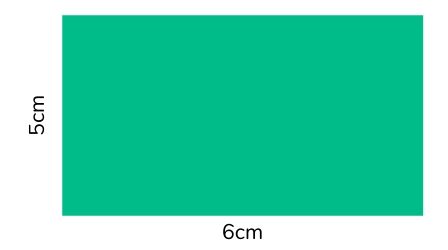
What is its area? Answer: 30cm2
3rd grade word problem: perimeter
The swimming pool at the Sunshine Inn hotel is 20m long and 7m wide. Mary swims around the edge of the pool twice. How many meters has she swum? Answer: 108m
5th grade word problem: ratio (crossover with measurement)
A local council has spent the day painting double yellow lines. They use 1 pot of yellow paint for every 100m of road they paint. How many pots of paint will they need to paint a 2km stretch of road? Answer: 20 pots
5th grade word problem: PEMDAS
Draw a pair of parentheses in one of these calculations so that they make two different answers. What are the answers?
50 – 10 × 5 =
50 – 10 × 5 =
5th grade word problem: volume
This large cuboid has been made by stacking shipping containers on a boat. Each individual shipping container has a length of 6m, a width of 4m and a height of 3m. What is the volume of the large cuboid? Answer: 864m3
Remember: The word problems can change but the math won’t
It can be easy for children to get overwhelmed when they first come across word problems, but it is important that you remind them that while the context of the problem may be presented in a different way, the math behind it remains the same.
Word problems are a good way to bring math into the real world and make math more relevant for your child. So help them practice, or even ask them to turn the tables and make up some word problems for you to solve.
Do you have students who need extra support in math?
Skye—our AI math tutor built by experienced teachers—provides students with personalized one-on-one, spoken instruction that helps them master concepts, close skill gaps, and gain confidence.
Since 2013, we’ve delivered over 2 million hours of math lessons to more than 170,000 students, guiding them toward higher math achievement.
Discover how our AI math tutoring can boost student success, or see how our math programs can support your school’s goals:
– 3rd grade tutoring
– 4th grade tutoring
– 5th grade tutoring
– 6th grade tutoring
– 7th grade tutoring
– 8th grade tutoring
